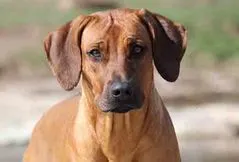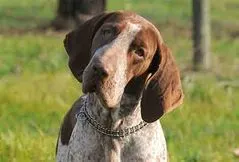
Rhodesian Ridgeback
The Rhodesian Ridgeback is easy to spot among a canine crowd: He’s the one with the tiny Mohawk running down his spine.
Overall Status
| Height | 24 to 27 inches |
| Temperament | Affectionate, Dignified, Even-Tempered |
| Weight | 70 to 85 pounds (male) |
| Life Expectancy | 10 to 12 years |
| Coat Color | Golden, Gray, Red, Wheaten, White |
| Barking Level | When Necessery |
Quick Factors
| Playfulness | |
| Dog Friendly | |
| Exercise Need | |
| Grooming Needs | |
| Strangers Friendly | |
| Family Affectionate |
Daily Care
Grooming Tips
Ridgebacks have an easy-care short coat. A Ridge will shed a bit all year long, but it’s not bad. Run a brush over his coat once a week, and bathe him when you think he needs it. Brush his teeth with vet-approved pet toothpaste, clean his ears, and trim his nails regularly, and that’s it.Thenailsshould be trimmed often if not worn down naturally, as overly long nails can cause the dog discomfort and problems walking and running. Many Ridgebacks resist nail clipping and many respond more positively to a nail grinder.
Exercise Tips
Capable of a lot of exercise – and indeed, they were bred that way – this is a great outdoor dog and a good companion for someone who wants to get plenty of vigorous exercise. If you’re looking for a low-maintenance dog that likes to lay around the house, this is not your breed.A shorter walk in the morning would be fine, but a longer more interesting one in the afternoon is a must. These dogs also like to be able to roam around a back garden as often as possible so they can really let off steam. However, the fencing has to be extremely secure to keep these high energy dogs in because if they find a weakness in the fence, they will soon escape out and get into all sorts of trouble. However, care has to be taken when walking a Ridgeback in the country or in the park because of their high prey drive. As such, letting a dog off their lead has to be in a secure and safe area.With this said, Ridgeback puppies should not be over exercised because their joints and bones are still growing. This includes not letting a dog jump up and down from furniture or going up or down the stairs. Too much pressure placed on their joints and spines at an early age could result in a dog developing problems later in their lives. The breed can also exercise mind and body by participating in canine sports liketracking,agility, and other activities that dog and owner can enjoy together.
Feeding Tips
A strong hunting breed known for being able to take out small animals – and even large ones – this dog will enjoy fresh meat of different varieties, from poultry to beef. Meat should be mixed in with whole, nutritious food aimed at giving the dog a healthy coat and satiating its appetite.If you get a Ridgeback puppy from a breeder, they would give you a feeding schedule and it's important to stick to the same routine, feeding the same puppy food to avoid any tummy upsets. You can change a puppy's diet, but this needs to be done very gradually always making sure they don't develop any digestive upsets and if they do, it's best to put them back on their original diet and to discuss things with the vet before attempting to change it again.Older dogs are not known to be fussy or finicky eaters, but this does not mean you can feed them a lower quality diet. It's best to feed a mature dog twice a day, once in the morning and then again in the evening, making sure it's good quality food that meets all their nutritional requirements.Treatscan be an important aid in training, but giving too many can cause obesity. Learn about whichhuman foodsare safe for dogs, and which are not. Check with your vet if you have any concerns about your dog’s weight or diet.Clean, fresh water should be available at all times.
Health Tips
The average life expectancy for the Rhodesian Ridgeback is between 10 and 12 years.Rhodesian Ridgebacks are generally healthy dogs, and responsible breeders screen their dogs for hip and elbow dysplasia, thyroid function and eye anomalies. Dermoid sinus is a tube-like opening in the skin that is occasionally present at birth; an experienced breeder can palpate, or feel, for this defect. Breed health concerns may include the following:Cataracts: Refers to any opacity of the lens of the eye. Dogs of either gender can develop cataractsCerebellar DegenerationDeafness: Defined as the lack or loss, complete or partial, of the sense of hearingDermoid SinusEntropion: The inversion, or the turning inward, of all or part of the edge of an eyelidEversion of the Cartilage of the Nictitating MembraneElbow Dysplasia: Leads to malformation and degeneration of the elbow joint, with accompanying front limb lamenessHip Dysplasia: Involves abnormal development and/or degeneration of the coxofemoral (hip) jointHypothyroidism: a clinical syndrome caused by inadequate production and release of the thyroid hormones triiodothyronine (T3) and thyroxine (T4)
Trainability
Redbone Coonhounds take well to training and are so versatile and athletic that they can accomplish a high variety of tasks. Giving them tasks to fulfill – from swimming to hunting – can help it not only feel fulfilled, but help it feel like it plays a role in your pack. Every dog should certainly feel this way about humans but should be trained with the discipline to realize that its role is subservient to every human in the house.Earlysocializationandpuppy training classesusing positive reinforcement are recommended and help to ensure that the dog grows into a well-adjusted, well-mannered companion.
History
The Redbone is one of the breeds that can be labeled “Made in America.” Like most of the Coonhound breeds, the Redbone descends fromFoxhounds,Bloodhounds, and possibly Irish hounds. The man who did the most to develop the breed was named George E. L. Birdsong, a well-known fox-hunter and dog breeder who lived in Georgia.In the late 19thCentury, Rhodesian big-game hunter Cornelius van Rooyen incorporated two ridged Greyhound-like females into his pack of lion dogs. He found that their ridged offspring excelled at confronting and confounding the king of beasts, giving the hunter time to sight in his rifle and dispatch his prey. These ridged dogs were also successful at fending off other dangerous animals such as leopards and baboons, trotting effortlessly alongside horse-mounted riders all day, breaking off to course quick-footed game such as antelope to provide meat for the pot, and protecting the homestead from all intruders. They were known then, as they are today, for their devotion to family, and tolerance and affection for its children.The American Kennel Club recognized the Redbone in 2009. The breed ranks 122ndamong the dogs registered by the AKC.






